
Gandhinagar is the capital of the state of Gujarat in India. Gandhinagar is located approximately 23 km north of Ahmedabad, on the west central point of the Industrial corridor between Delhi, the political capital of India, and Mumbai, the financial capital of India.

Ahmedabad is the most populous city in the Indian state of Gujarat. It is the administrative headquarters of the Ahmedabad district and the seat of the Gujarat High Court. Ahmedabad's population of 5,570,585 makes it the fifth-most populous city in India, and the encompassing urban agglomeration population estimated at 6,357,693 is the seventh-most populous in India. Ahmedabad is located near the banks of the Sabarmati River, 25 km (16 mi) from the capital of Gujarat, Gandhinagar, also known as its twin city.
This page provides a historical timeline of Ahmedabad, the sixth largest city in India.
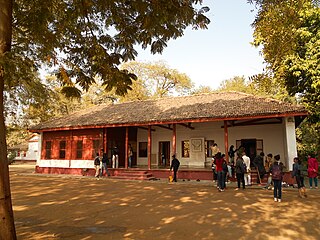
Sabarmati Ashram is located in the Sabarmati suburb of Ahmedabad, Gujarat, adjoining the Ashram Road, on the banks of the River Sabarmati, 4 miles (6.4 km) from the town hall. This was one of the many residences of Mahatma Gandhi who lived at Sabarmati (Gujarat) and Sevagram when he was not travelling across India or in prison. He lived in Sabarmati or Wardha for a total of twelve years with his wife Kasturba Gandhi and followers, including Vinoba Bhave. The Bhagavad Gita was recited here daily as part of the Ashram schedule.

The Sabarmati river is one of the major west-flowing rivers in India. It originates in the Aravalli Range of the Udaipur District of Rajasthan and meets the Gulf of Khambhat of Arabian Sea after travelling 371 km (231 mi) in a south-westerly direction across Rajasthan and Gujarat. 48 km (30 mi) of the river length is in Rajasthan, while 323 km (201 mi) is in Gujarat.

Motera is a neighbourhood in the northwestern part of the metropolis of Ahmedabad in Gujarat, India. It lies west of the Sabarmati River. It falls under the West Zone of Ahmedabad Municipal Corporation and under the Gandhinagar South constituency of Gujarat Legislative Assembly and under the Gandhinagar constituency of the Lok Sabha. The chief attraction in Motera is the world's largest sports stadium, Narendra Modi Stadium. The stadium is the venue for the international cricket matches held in Ahmedabad. In 2015, old stadium was demolished and new stadium was built which got the honour of world's largest stadium.
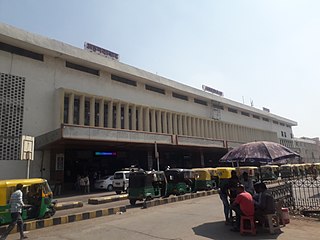
Ahmedabad Junction railway station is the main railway station of Ahmedabad, Gujarat, India. It is also the biggest railway station within Gujarat and also one of the major railway station in India. It is the highest income-generating division in Western Railways. It connects to Mumbai, Chennai, Delhi, Howrah and other major cities of India. Also it is central railway station of Gujarat which connects to Saurashtra, Kutch, Vadodara, Surat, Himmatnagar, Bhavnagar, Palanpur, etc.
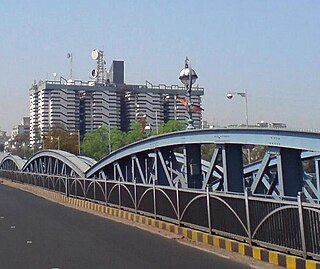
The Ellis Bridge is a century-old bridge in Ahmedabad, Gujarat. It bridges the western and eastern parts of the city across the Sabarmati river. This bowstring arch truss bridge was the first bridge in Ahmedabad, constructed in 1892. Concrete wings were added on either side in 1997 and it was renamed the Swami Vivekananda Bridge.
The textile industry of the city of Ahmedabad in the state of Gujarat in India dates back to the 19th century, when the city and the industry was established under the British raj. Textile mills employed thousands of people from across the state, and the cotton garments manufactured were exported around the world. The prosperity of the industry was the mainstay of the city's economy. It is called the "Manchester of India". Thus, the Ahmedabad is officially famous for cotton textile works.

Sabarmati Riverfront is a waterfront being developed along the banks of Sabarmati river in Ahmedabad, India. Proposed in the 1960s, the construction began in 2005. Since 2012, the waterfront is gradually opened to public as and when facilities are constructed and various facilities are actively under construction. The major objectives of project are environment improvement, social infrastructure and sustainable development.
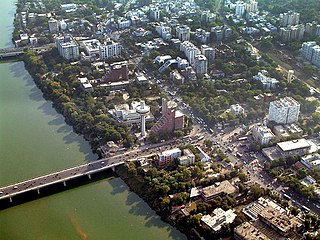
Ahmedabad is located on the banks of the River Sabarmati in the northern part of Gujarat and the western part of India. It is located at 23.03°N 72.58°E spanning an area of 205 km². The average elevation is 53 metres.
Ashaval or Ashapalli or Yashoval is the first name of Ahmedabad or Amdavad. Archaeological evidence suggests that the area around Ahmedabad in the state of Gujarat, India has been inhabited since the 11th century, when it was known as Yashoval or Ashapalli or Ashaval. The city of Ashaval was located on the east of River Sabarmati. Existence of Ashawal is traced way back in 9th - 10th century up till 13th century. The Ahmedabad is a popular settlement near bank of Sabarmati river was earlier known as Ashaval or Ashapalli. In the tenth century Ashaval was one of the chief places in Gujarat as described by Al-Biruni. It was a well peopled, busy, trading, manufacturing and rich town around 1150.

The Ashram Road is one of the major roads in the city of Ahmedabad in India. A major portion of the road runs parallel to the Sabarmati. The road is a major financial hub of the city with the offices of the Reserve Bank of India and the Income Tax department located on the road. The road is also a tourist destination with the Sabarmati Ashram and the City Gold multiplex located on the road. Several of the best showrooms for sarees and traditional clothing like Asopalav and Anupam are situated on this road.
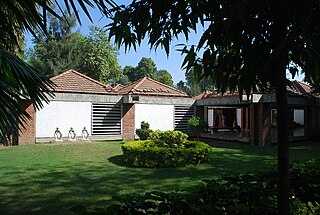
The Gandhi Smarak Sangrahalaya is a museum and public service institution dedicated to preserve the work and memory and commemorate the life of Indian leader Mahatma Gandhi. It is located at Gandhi's Sabarmati Ashram in Ahmedabad, India on the banks of River Sabarmati. It houses tens of thousands of letters to and by Gandhi, as well as photographs and books.
Subhash Bridge is a bridge over Sabarmati River, built in 1973. It is an important area in Ahmedabad for its association with Mahatma Gandhi. Gandhi Ashram is 1.5 km away from Subhash Bridge. Gandhi Ashram Shopping area is a storehouse of Khadi. Subhash Bridge stands as a residential area of Ahmedabad with more than 80 residential societies spread across this place. It has been separated from rest of the city by a railway line in the west and Sabarmati river at its eastern side.
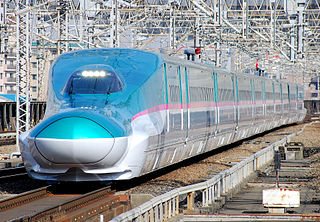
Mumbai–Ahmedabad High Speed Rail Corridor (MAHSR) or Mumbai–Ahmedabad HSR is an under-construction high-speed rail line connecting India's economic hub Mumbai with the city of Ahmedabad. When completed, it will be India's first high-speed rail line.
Ellis bridge is an area located in Ahmedabad, India.

Manek Burj, also spelled Manek Buraj is the foundation bastion of Bhadra Fort in the old city of Ahmedabad, Gujarat, India. The Burj is associated with legendary saint Maneknath.
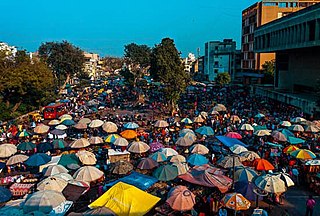
Ravivari market or Gujari Bazar is a market at the Sabarmati riverfront in Ahmedabad, India. It occurs every Sunday. Used items and antique pieces are sold there.

Atal Pedestrian Bridge is a pedestrian triangular truss bridge at Sabarmati Riverfront on Sabarmati river in Ahmedabad, Gujarat, India. It has a design inspired by kites. Inaugurated in 2022, it is 300 metres (980 ft) long and 10 metres (33 ft) to 14 metres (46 ft) wide.
















